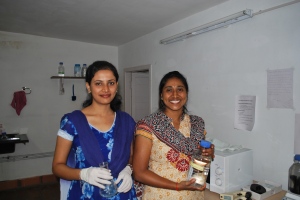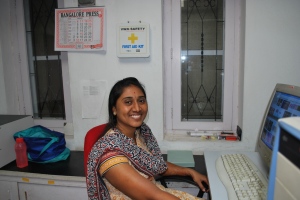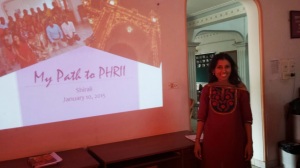It’s been a while since I wrote a blog entry and a lot has happened! Since it’s a new calendar year, I thought I’d start it off by trying to catch up on my posts and recap some of the highlights of the last few months of 2014. It’s a pretty daunting task to cover everything I’ve been up to so it might take a few entries :).
I’ve been hard at work at PHRII. I go to the Prerana Health Clinic in downtown Mysore a couple times a week to collect clinical samples for my study.
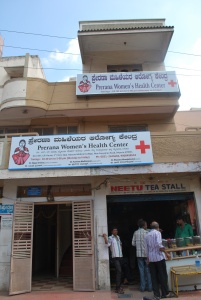
Prerana Health Clinic in downtown Mysore
I work with a great team of medical counselors, nurses, physicians and microbiologists who all support me immensely with study recruitment and the sample collection process. I’ve been learning a lot about cytology and microbiology, since we need to identify the disease status of these women before recruiting them into the study.
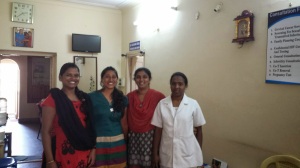
Rani, Kavitha, Rashmi and Chandramani – the clinic team!
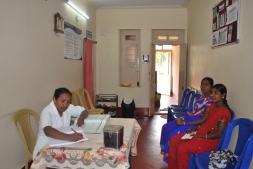
Chandramani registering patients for the study
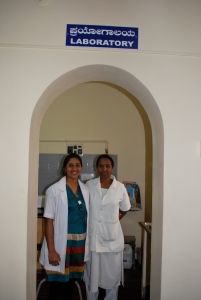
Kavitha and Chandramani in the clinic lab
Since this is the first time I’m conducting a public health research project, the study recruitment and clinic work is where I’m learning the most. For example, I now have to consider the comfort of the study participants while deciding how many samples to collect from each woman – something I never had to consider before while working with insects (or cultured cells) as model organisms 😉 Depending on human participants has also meant that there is a bit more unpredictability than I’ve been used to in my research thus far; for example the number of samples we obtain in any given week depends on how many women come into the clinic and their willingness to participate in our study. On one occasion a woman agreed to participate in the study, completed the study consultation and forms, only to subsequently flee from the exam table, mortified at the prospect of a pelvic exam!
From the clinic, we bring samples back to the lab at PHRII for processing and to identify the microbes in the samples using molecular techniques.
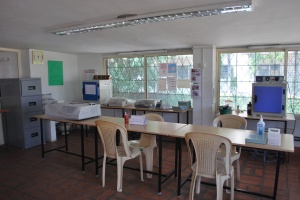
Serology room
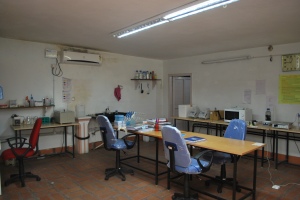
Molecular biology room
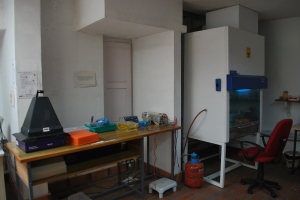
Fume hood and electrophoresis apparatus
While I’m familiar and comfortable with most of the techniques I’m using in the lab here, there have also been many things for me to learn in this stage of the study, such as how to grow bacteria anaerobically. I’ve also had to learn to plan the lab experiments from A to Z, from budgeting my funds to ordering all the materials and reagents I need in the lab many months in advance. Materials can take up to a month or more to arrive here, since things need to be delivered via Bangalore, almost 4 hours away. This is quite different from what I was used to at Berkeley, just running downstairs to the Barker storeroom to grab a reagent at the last minute! Needless to say, I’ve had to plan things far in advance :).
In the lab too, I have had great help from 3 research assistants, Kavitha, Anisa and Fathima, who are an incredible support team for the project. They keep everything on the lab side of my project running smoothly.
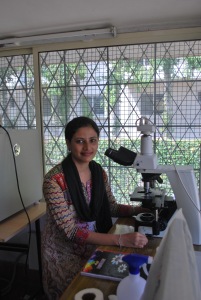
Fathima at the ‘scope
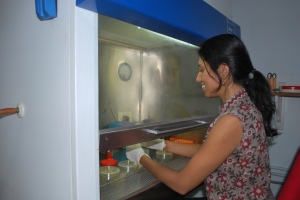
Me, hard at work in the hood
Not to mention they make for a great time chatting, singing and hanging out in the lab. Fathima is a great mehndi artist and yesterday she put on mehndi for Kavitha and me.
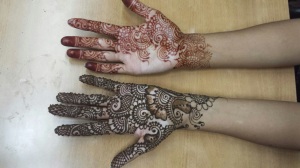
Mehndi break!
They also teach me “svalpa svalpa” (or “little little”) Kannada in our downtime :).
Two weeks ago I gave a seminar to the PHRII staff. I talked about my path to PHRII and to global health. Even though I’ve now been here for over 5 months, it was a nice way to formally introduce my project, my background and reasons for coming here. I think it helped the PHRII staff understand what I am working on here and helped those who work with me – especially those who work with me in the clinic – feel more involved and motivated to help me with the study and make sure I reach my goals.
It’s been incredibly gratifying to be able to put human faces to the work I’m doing. As I mentioned in my previous blog post, seeing the human aspect helps adds a great deal of context and relevance to my work. While there have certainly been challenges and frustrations along the way (working in India can certainly be an exercise in patience), it’s been a very positive experience so far – a great combination of using methods I’m familiar with to contribute while learning about public health research.
